Smart thermostats offer precise temperature control and energy efficiency tailored to your pet's comfort, automatically adjusting settings based on real-time data and occupancy patterns. Manual thermostats require constant human intervention and often fail to maintain optimal heating or cooling, potentially causing discomfort to pets during extreme weather. Integrating a smart thermostat enhances your pet's well-being by providing a consistently comfortable environment while reducing energy costs.
Table of Comparison
| Feature | Smart Thermostat | Manual Thermostat |
|---|---|---|
| Temperature Control | Automated, app-controlled, remote access | Manual adjustment only |
| Energy Efficiency | Optimizes heating/cooling schedules to save energy | No energy-saving features |
| Learning Capability | AI-driven learning based on user behavior | None |
| Integration | Compatible with smart home systems (Alexa, Google Home) | No smart home integration |
| Cost | Higher initial cost, potential long-term savings | Low upfront cost, no savings features |
| Installation | Requires technical setup | Simple installation |
| User Interface | Touchscreen and smartphone app | Physical dials or switches |
Smart Thermostat vs Manual Thermostat: Key Differences
Smart thermostats offer programmable schedules, remote control via smartphone apps, and energy usage reports, enhancing convenience and efficiency compared to manual thermostats that require manual adjustments. Unlike manual models, smart thermostats learn user preferences and adjust temperatures automatically, optimizing energy consumption and reducing utility bills. Integration with smart home systems enables smart thermostats to sync with other devices, providing seamless climate control and improved home automation.
Benefits of Smart Thermostats for Homeowners
Smart thermostats offer precise temperature control through learning algorithms that adapt to homeowner routines, significantly reducing energy consumption and utility bills. They enable remote access via smartphone apps, allowing users to adjust settings from anywhere, enhancing comfort and convenience. Integration with other smart home devices provides seamless automation, improving overall energy efficiency and home management.
Energy Efficiency: Smart vs Manual Thermostats
Smart thermostats optimize energy consumption by learning user habits and adjusting temperatures automatically, resulting in savings of up to 15% on heating and cooling costs. Manual thermostats require constant human intervention, often leading to inefficient energy use due to inconsistent temperature management. Advanced features like remote control and adaptive scheduling make smart thermostats significantly more energy-efficient compared to traditional manual models.
Installation Process: Which Thermostat Is Easier?
Smart thermostats generally feature more complex installation processes due to their reliance on Wi-Fi connectivity and compatibility with various HVAC systems, requiring precise wiring and app setup. Manual thermostats offer simpler installation, often involving just basic wiring to existing systems without the need for network configuration. Homeowners seeking straightforward installation typically find manual thermostats easier to install, while those comfortable with technology may prefer the advanced features of smart thermostats despite the more involved setup.
Cost Comparison: Upfront and Long-Term Savings
Smart thermostats typically have a higher upfront cost, ranging from $150 to $300, compared to manual thermostats priced around $20 to $50. Long-term savings from smart thermostats can reach 10-15% on heating and cooling bills due to programmable schedules and adaptive learning technology. Manual thermostats lack energy efficiency features, often resulting in higher utility expenses over time despite the lower initial investment.
User Experience: Convenience and Control
Smart thermostats offer enhanced user experience by providing remote control via mobile apps, allowing precise temperature adjustments from anywhere. These devices learn user preferences over time, optimizing energy usage and maintaining comfort without manual intervention. In contrast, manual thermostats require physical adjustments and lack adaptive features, limiting convenience and control for users.
Integration with Smart Home Ecosystems
Smart thermostats seamlessly integrate with smart home ecosystems such as Amazon Alexa, Google Home, and Apple HomeKit, enabling voice control and automated temperature adjustments based on user habits and occupancy. Manual thermostats lack connectivity features, requiring manual operation without the benefits of remote access or smart automation. Integration of smart thermostats enhances energy efficiency and convenience by syncing with other smart devices like sensors and lighting systems.
Remote Access and Automation Features
Smart thermostats offer remote access through mobile apps, allowing users to adjust home temperatures from anywhere, enhancing convenience and energy efficiency. Automated scheduling and learning algorithms optimize heating and cooling patterns based on occupancy and preferences, unlike manual thermostats that require physical adjustments. Integration with smart home ecosystems enables seamless control and energy management, which manual thermostats lack.
Maintenance and Troubleshooting
Smart thermostats reduce maintenance by offering remote diagnostics and automatic software updates that enhance performance and detect issues early. Manual thermostats require regular physical inspections and manual recalibration, which can increase downtime and maintenance costs. Troubleshooting smart thermostats is streamlined through app-based alerts and support, whereas manual thermostats demand hands-on technical expertise.
Which Thermostat Is Right for Your Home?
A smart thermostat offers remote control, learning algorithms, and energy-saving features that adapt to your schedule, making it ideal for tech-savvy homeowners seeking convenience and efficiency. Manual thermostats provide straightforward temperature control without automation, suitable for those who prefer simplicity and lower upfront costs. Evaluating your lifestyle, budget, and energy goals will help determine whether a smart or manual thermostat is the right fit for your home.
Smart Thermostat vs Manual Thermostat Infographic

 techiny.com
techiny.com